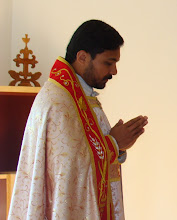The interpreters of eastern liturgies highlight the ‘Epiclesis’. The epiclesis is that part of the Qurbana in which the priest calls upon the Holy Spirit to bless the offerings and prays that they may become the body and blood of our lord Jesus Christ. The western liturgy attributes more importance to the ‘words of Institution’. The institution narrative is that part of the Qurbana in which the priest recites the so called words of institution of Qurbana (…this is my body,,, this is my blood….) over the elements of bread and wine. The Eastern churches teach also that the bread and wine mysteriously become the body and blood of Christ sometime during the whole Anaphora (Quudasa, Eucharistic prayer). Here comes the importance of the Mar Thoma Nazrani Church (Syro Malabar Church) and its liturgy. The liturgical theology of our church is beyond all these. We have to note two points here.
1. At present we use the Anaphora of Mar Addai and Mar Mari. In the original text we cannot find the “words of institution”.
2. Even before the Anaphora we call the bread and wine the body and blood of Christ. Eg.’Misiha Karthavin thirumey ninavumitha……….., nammude karthaveeso Misihayude thirusarreram kondu e peelasa roosma cheyyapedunnu……….etc.
These all highlight how much importance our forefathers gave to the concept of mystery. For them the whole Qurbana is important from its very beginning (Puqdhanakon) to its end ( the final Amen). Transforming the bread and wine into the body and blood of Christ is the work of the Holy Spirit. We are just tools. That is why the Church says people should participate in the Qurbana from the very beginning to the very end. That is why the Church insists that every prayer of the Qurbana is important and any celebrant or participant is not allowed to skip or add to the prayers according to their whims and fancies. At any time in the Qurbana the ‘transubstantiation’ can be seen as taking place. It is the work of the Holy Spirit and it is a great Mystery.



No comments:
Post a Comment